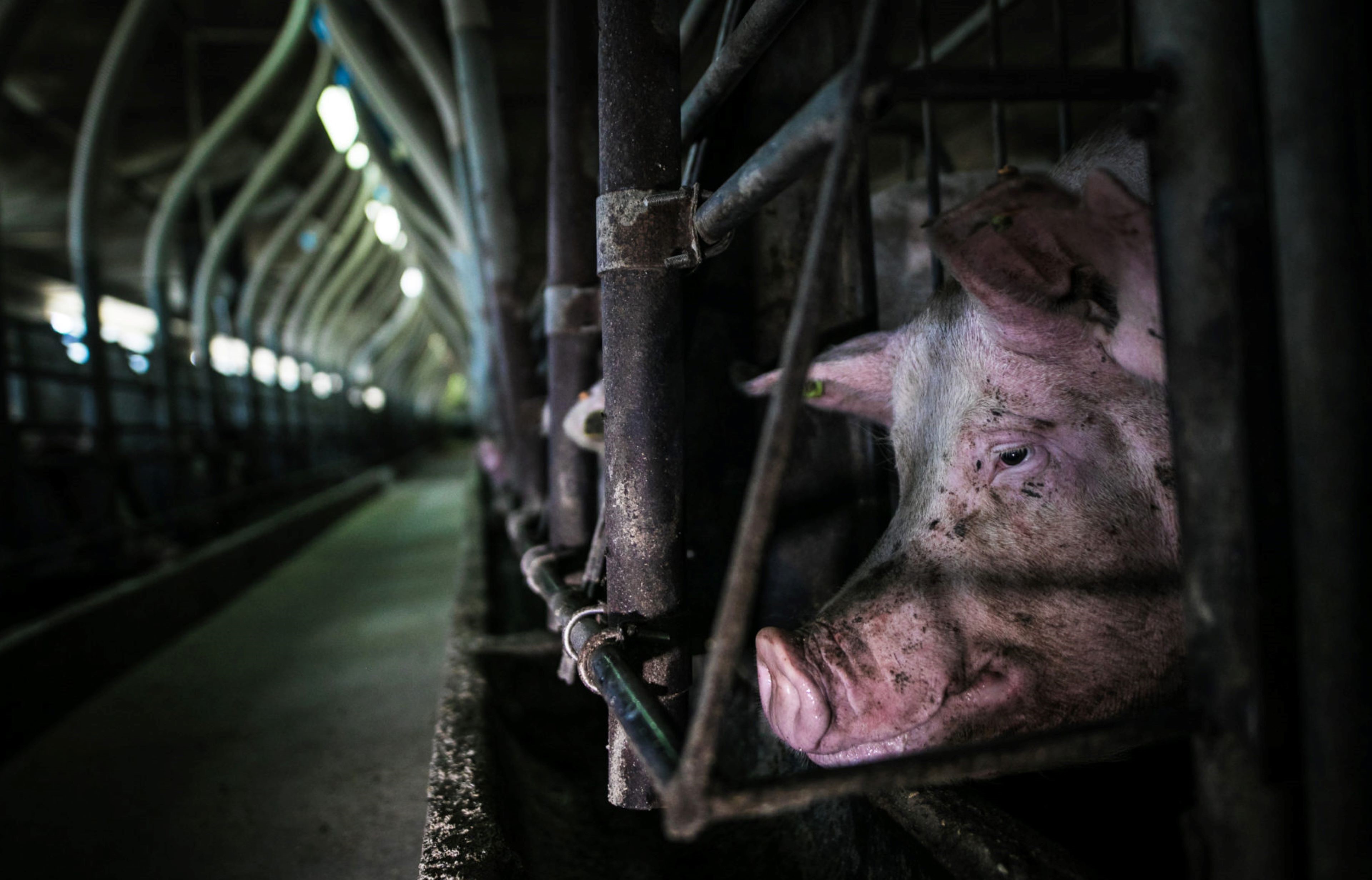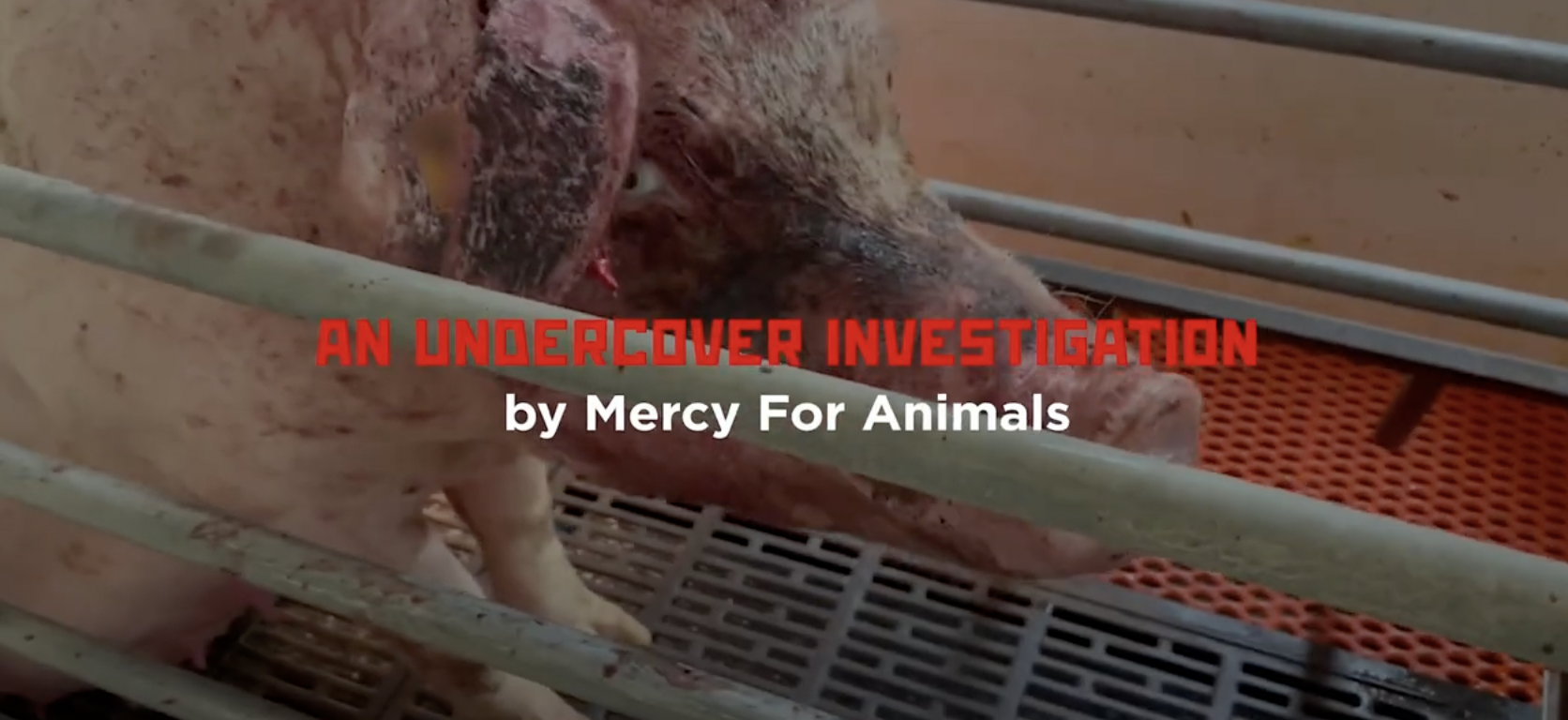Most of us have no idea where our meat comes from. Even less of us know about the conditions of the “farm” and welfare of the animals that we consume. There’s a reason for this. Commercial farming, especially CAFO (Concentrated Animal Feeding Operation) practices are highly secretive. If the public knew what was really going on, a lot of us would turn vegan tomorrow. This article from thehumanleague.org uncovers one of many inhumane factory farming practice: Gestation Crating. This article may not turn you into a vegan, but hopefully it gets you to start asking questions, and start thinking about where you source your meat.
The meat industry repeatedly impregnates female pigs so it can raise and kill their newborn piglets. These female pigs will spend their entire pregnancies trapped in a “gestation crate”—a metal cage that is so tight, a pig can’t even turn around.

Mother pigs have an instinct to love, protect, and nurture their newborn babies, just like humans do. However, the meat industry doesn’t see female pigs as mothers with the capacity to love. Instead, they treat mother female pigs, known as “sows,” like breeding machines. Pork producers keep their sows in tight gestation crates throughout their lives, artificially impregnate them over and over, and take away their piglets at just a few weeks old. To keep up with the demand for pig flesh, female pigs must be forced to continually pump out piglets. Thanks to the conditions in which they’re kept, sows—as these mothers are called—are among the most abused animals on the planet.
Pigs are intelligent, social, and caring animals with strong maternal instincts. In the wild, a pregnant pig will walk several miles to carefully select the perfect spot to build a nest for her newborns. After she welcomes her babies into the world, they’ll spend the first few months of their lives with their mother, nursing, grooming, playing, and foraging for food together.
In factory farms, this natural maternal bond is broken. A mother pig will never be able to feel sunshine on her skin or grass beneath her hooves. She only knows the cold, iron confines of a gestation crate. She spends the entirety of her pregnancies and nursing periods confined in a metal cage, barely able to move. She will continue producing piglets destined to be killed for meat and, after just two years of life, she will meet the same fate.
Sadly, this abuse is standard in the pork industry, where companies see pigs as machines for maximizing profit. Several countries have banned the use of cruel gestation crates entirely, but millions of sows across the US still suffer through these horrific conditions every day.
What are gestation crates for pigs?
Gestation is another way to refer to the period when an animal is pregnant before giving birth. A sow is pregnant for almost four months before the arrival of her babies.
For humans, pregnancy can be an exciting and momentous time, as families prepare and anticipate the joy of welcoming a new life into the world.
However, imagine if a mother was kept in a cage barely bigger than her body for most of her pregnancy, unable to walk or move more than a few steps, unable even to turn around, able to interact only with the two mothers on either side of her, who are also caged. Imagine if her water came spouting from dirty pipes at the front of this cage, with a food trough below. Imagine floors slatted to allow excrement to flow downwards before collecting in vast outdoor lagoons. Factory farms imprison mother pigs in these conditions for the entirety of their four-month pregnancies.
Gestation crates enclose pigs in a space of about seven feet by two feet—an area barely larger than the pig’s body. A mother pig will remain in this minuscule space for the entirety of her pregnancy.
After birth, mother pigs do not get a chance to care for their babies as they naturally want to. Instead, pork producers take each litter of piglets from their mother when they’re around only three weeks old, raising and killing them for food. This separation is not only traumatic for the mother and her babies, it’s unnatural. In nature, mother pigs nurse their babies for up to 17 weeks.
Then, the exploitative cycle starts again. The industry repeatedly impregnates sows, forcing them to give birth to new litters of piglets until their bodies are completely exhausted. When a sow is “spent”—no longer able to give birth—she goes to slaughter at only around one and a half to two years old. In the wild, pigs can live up to 20 years.
Just this year, our colleagues at Mercy For Animals released evidence from a heartbreaking investigation that shines a light on the cruelty that mother pigs endure in gestation crates. (Graphic content warning)

What is the difference between a farrowing crate and a gestation crate?
Gestation crates and farrowing crates are both extremely cruel forms of confinement that prevent pigs from standing or turning around. The main difference is that factory farms confine pigs in gestation crates during pregnancy, and keep pigs in farrowing crates after they give birth to a litter of piglets.
In the last few days of the pregnancy, sows move to farrowing crates, where they give birth to their piglets. These crates closely resemble gestation crates in that they enclose the mother’s body without enough room for the pig to turn around. But one side of the gate is grated, allowing the piglets to access the mother pig to nurse. The farrowing crate ultimately protects against a mother pig accidentally crushing her piglets, but it does so by completely preventing a mother pig from accessing her newborn piglets. She can’t build a nest for her piglets, groom them, bond with them, or communicate with them as she would in the wild.
Both gestation and farrowing crates are standard in the multi-billion dollar pork industry, which views mother and baby pigs as mere products—a way to make the most profits at the pigs’ expense.
How many pigs are in a gestation crate?
Each gestation crate confines one pig, allowing farmers to pack thousands of pigs in a single facility. She suffers alone in the tiny crate—a crate that is her entire world for so much of her short life.
As if spending most of each pregnancy alone in a gestation crate wasn’t traumatic enough, she endures more isolation in the vulnerable time following birth. After birth, she moves to a farrowing crate, where she cannot interact or show affection to her newborn babies.
Why do farmers use gestation crates?
The meat industry uses gestation crates to maximize profits at the expense of animals’ physical and mental well-being. By keeping pregnant pigs confined in the small crates, industrial farmers can crowd thousands of breeding sows inside a single shed. They don’t need to worry about controlling the amount a sow eats or handling the unique social hierarchies that sows establish in the wild. Housing pigs like this requires the bare minimum of personnel needed to manage the animals.
While industrial farmers argue that sows have more piglets when confined to gestation crates, a new study shows that these crates are actually less productive. Researchers analyzed 17 different countries: some where gestation crates are the norm, some where the crates are restricted, and others where gestation crates are completely banned. They found that rates of sow mortality were highest in countries with gestation crates. And not only that—they found that pig production per sow was “significantly lower” in those countries, too.
Due to the sheer amount of individual sows in a shed, many pigs face severe forms of neglect and horrific conditions. They wallow in built-up feces and filth. They rarely receive care for any of the pain or injuries they suffer from life in the crate. Some are even left to die on the concrete floors of factory farms. Although tragic, the industry overlooks these premature losses. They only want to keep mother pigs alive long enough to produce between three and five litters of piglets.
Why are gestation crates bad?
The pork industry treats female pigs as breeding machines, who produce litter after litter of piglets to raise and kill for food. When the industry can no longer profit off of a female pig’s body, they will kill her, too. Because of this, most research on gestation crates focuses on how they impact “reproductive performance” in pigs. They ignore how much pigs suffer physically and emotionally in such extreme confinement.
Behavioral restriction
Gestation crates confine pigs so tightly that she can’t even turn around, let alone move enough to engage in natural behaviors. This intensive physical restriction wears away at her bones and exhausts her muscles until she is overcome by constant pain. According to the USDA, Gestation crates weaken pigs’ cardiac functions, immune systems, and bone strength. They suffer the loss of muscle mass and overgrown hooves from lack of movement. They lack access to any clean water, leading to dehydration. Their filthy, bacteria-laden surroundings make them susceptible to painful urinary tract infections.
Sadly, due to their unnatural confinement, behaviors that normally help pigs survive end up hurting them even more. Pork producers prevent pigs from putting too much weight on while they are pregnant by depriving them of adequate food. To relieve their starvation, pigs resort to reaching for food from a neighboring trough, injuring themselves in the process.
Confinement injuries
In the small confines of a gestation crate, a pig risks painful injuries. A sow will often develop sores and abrasions from rubbing against the bars that confine her, or foot problems from constantly standing on hard, grated flooring. The constant pressure on the pigs’ skin results in painful lesions.
Stereotypy
Stereotypy describes when an animal engages in repetitive behaviors to cope with stress, including swaying, nodding, or biting on cage bars for an extended period. Animals showcase stereotypic behaviors in environments where they are captive, bored, and stressed out, like factory farms and zoos.
Pigs, bored and frustrated in their crates, use stereotypic behaviors to cope. But, their coping mechanisms do more harm than good: they bite over and over at the hard metal bars of their crates, and the friction creates painful sores inside their mouths.
Are gestation crates still used?
Sadly, the pork industry still uses gestation crates as standard practice.
There is no federal ban on gestation crates in the US. This cruel form of confinement is the norm in factory farms. According to a 2018 survey by the National Pork Producers Council, 80% of pork producers use gestation crates as standard practice.
Where are gestation crates banned?
Some countries have already banned gestation crates for their cruelty. Sweden was the first nation to ban gestation crates outright in 1994. In 2013, the European Union restricted the use of gestation crates to the first four weeks of a sow’s pregnancy, and the UK banned their use entirely.
Though the US lacks a nationwide ban on gestation crates, several states have already taken action to protect pigs by enacting bans, including Maine, Florida, Rhode Island, and Massachusetts, among others.
The biggest sign of progress toward banning crates came in 2018 when California voted to pass the Farm Animal Confinement Initiative, also known as Proposition 12. The legislation establishes minimum space requirements for all farmed animals and bans the sale of pork from pigs kept in gestation crates altogether. Prop 12 is among the strongest animal protection laws in the United States, sending a message to meat companies that they can’t continue to profit off of the worst forms of abuse.
In October 2022, the pig industry challenged Prop 12 in front of the Supreme Court of the United States, arguing for the right to keep pigs in cages. Along with our partner organizations, The Humane League’s legal counsel mounted a valiant defense. The Supreme Court’s decision is expected in the spring or summer of 2023.
As consumers become more aware of the horrific conditions pigs experience, more companies will have to answer for their use of gestation crates. Without a meaningful policy, pork producers make empty promises about banning gestation crates, which some have already failed to live up to. Legislation is important to ensure that corporations live up to their animal welfare claims and don’t mislead concerned consumers.
Are there alternatives to using gestation crates?
Like most standard factory farm practices, gestation crates’ ultimate purpose is maximizing profits. Keeping pigs in the tightest spaces possible allows meat producers to fit thousands of pigs into a single farm, raising their bottom line at the expense of animal welfare. To protect their profits, pork producers often claim that there are no viable alternatives to the cruelty of crate confinement. However, less cruel alternatives do exist.
Instead of confining sows to individual cages, some farms opt for group housing—one of the most common alternatives to gestation crates. In group housing, animals have the freedom to move around and socialize with other pigs, free from the confines of an individual crate.
Although preferable to the agony of crate confinement, pigs still suffer in group housing. Group housing doesn’t guarantee outdoor access, nor does it prevent overcrowding. The pens can have the same slatted floors as gestation crates, making for entirely barren environments. Pigs still spend their entire life in a filthy, windowless shed, without ever seeing the sun.
Small farms use pasture systems as a more natural, humane option for raising pigs. In these systems, farmers leave herds of pigs to their own devices, allowing them to roam around outside and take shelter in huts that they frequent at their choosing. Although pasture systems provide pigs with a much better life, sadly, pasture systems account for less than 3% of meat production in the US. 97% of pigs experience life on a factory farm.
The bottom line is that millions of pigs suffer to end up on our plates, enduring cruel practices that are standard across the industry. However, switching to alternatives like group housing protects pigs from the worst form of confinement, allowing them to move with more freedom and sparing them from the painful injuries of crate confinement. Banning gestation crates and switching to alternative systems is a crucial first step toward a future where no pig has to suffer through life in the confines of a factory farm.
What you can do
Pigs are unique individuals with their own thoughts, feelings, and personalities, not unlike the dogs and cats we share our homes with. However, our broken food system does not treat pigs like the gentle, sentient beings that they are. Instead, it treats pigs like products for consumption. Sadly, an estimated 129 million pigs were killed in 2019 in the US alone.
To satisfy consumers’ demand for meat and maximize profits, pork producers subject pigs to the worst forms of cruelty in factory farms. Gestation crates are the most heinous ways meat producers cut corners in factory farms, inflicting a lonely life of extreme confinement on pregnant and mother pigs.
Mother pigs and their babies deserve better. While legislators and animal activists make efforts to ban the use of gestation crates, the best thing that you can do to stand up to the meat industry’s abuse is to leave pork products off your plate.
Thankfully, leaving animals off your plate is easier than ever, especially now that there is an ever-growing variety of plant-based foods that mimic all kinds of meat. These compassionate, plant-based alternatives are not only kinder to animals—they are good for your health and for the planet, too!


